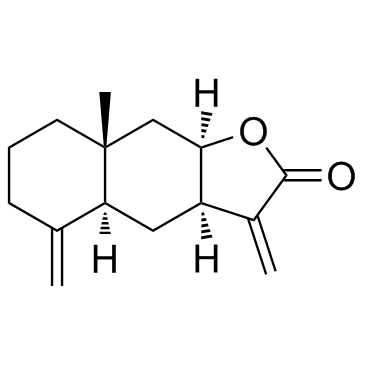470-17-7
| Name | isoalantolactone |
|---|---|
| Synonyms |
iso-Alantolactone
ISOHELENIN ISOALANTOACTONE (3aR,4aS,8aR,9aR)-8a-Methyl-3,5-bis(methylene)decahydronaphtho[2,3-b]furan-2(3H)-one isolantolactone Isoalantolactone MFCD00056777 (3aR,4aS,8aR,9aR)-8a-methyl-3,5-dimethylidenedecahydronaphtho[2,3-b]furan-2(3H)-one |
| Description | Isoalantolactone is an apoptosis inducer, which also acts as an alkylating agent. |
|---|---|
| Related Catalog | |
| Target |
Apoptosis[1] |
| In Vitro | Isoalantolactone exhibits good cytotoxic activity against the K562 human leukaemia cell line (IC50=1.2 μM) [1]. The cytotoxic effect of Isoalantolactone on pancreatic carcinoma is evaluated using PANC-1, BxPC3 and HPAC cell lines. Treatment with Isoalantolactone for 24 h inhibits PANC-1 cell growth in a dose-dependent manner. The inhibition rate is above 90% at 80 µM and the concentration to achieve 50% growth inhibition (IC50) is 40 µM. A similar trend in loss of cell viability is observed in BxPC3 and HPAC cells on Isoalantolactone treatment with IC50 values 43 and 48 µM respectively. Pretreatment with 3 mM N-Acetyl Cysteine (NAC), a specific ROS scavenger, restores the viability of cells indicating that Isoalantolactone exerts cytotoxic effect on cell viability through ROS generation[2]. |
| In Vivo | The acute and chronic toxic effects of Isoalantolactone in CD1 mice are assessed by measuring the changes in body weight, blood biochemistry and histopathology of liver and kidneys in comparison with control groups. Isoalantolactone is well tolerated by mice and no mortality or any sign of pharmacotoxicity are found at a dose of 100 mg/kg during both experimental periods (7 & 30 days). Body weight gains and food consumption are comparable for control and treated mice during both experimental periods and there were no drug-related changes in histopathological and blood biochemistry parameters. The histopathological changes in liver and kidneys are assessed using hematoxylin and eosin staining and correlated with liver and renal function biomarkers. No obvious morphological changes are observed in liver and kidney structures of control and treatment groups. There is a slight increase in serum alanine aminotransferase (ALT) and aspartate aminotransferase (AST) level of treatment group at dose day 7 but this increase is not significantly different (P<0.05) from control group. A significant increase in total bilirubin (TBIL) concentration is found in treatment group (1.43±0.26 vs 0.76±0.12 in control, P<0.05) at dose day 7. Similarly the changes in renal function biomarkers are not significantly different (P<0.05) in the serum of control and treatment groups at dose day 7. The concentration of creatinine (Cr) slightly increases whereas concentration of blood urea nitrogen (BUN) slightly decreases in treatment group. The serum level of AST, ALT, TBIL and BUN slightly decreases when mice are injected with Isoalantolactone at a dose of 100 mg/kg for 30 days[2]. |
| Cell Assay | Cell viability is assessed by MTT assay. Briefly PANC-1, BxPC3, and HPAC cells are treated with DMSO or Isoalantolactone (5, 10, 20, 40, 80 and 100 μM) in the presence or absence of 3 mM NAC for 24 h. Following treatment, the MTT reagent is added (500 µg/mL) and cells are further incubated at 37°C for 4 h. Subsequently 150 μL DMSO is added to dissolve farmazan crystals and absorbance is measured at 570 nm in a microplate reader. The percentage of cell viability is calculated[2]. |
| Animal Admin | Mice[2] In vivo studies for acute and chronic toxicity are conducted on 10-12 week old CD1 mice weighing 27-30 g. The mice are maintained in a specific pathogen-free grade animal facility on a 12-h light/dark cycles at 25±2°C. Mice are randomly divided into four groups. Group A (n=4) administered with 50 µL DMSO intraperitonially for 7 days; Group B (n=4) administered with Isoalantolactone (100 mg/kg body weight) in 50 µL DMSO intraperitonially for 7 days; Group C (n=4) administered with 50 µL DMSO for 30 days and Group D (n=4) administered with Isoalantolactone (100 mg/kg body weight) in 50 µL DMSO intraperitonially for 30 days. At the first and last day of the experiments, the body weight of each mouse is measured. At the end of experiments (at dose day 7 for acute toxicity & dose day 30 for chronic toxicity), mice are anesthetized using Pentobarbital sodium (50 mg/kg ip), blood is collected via cardiac puncture, allowed to clot for 10 min and centrifuge at 1000×g for 10 min at room temperature. Serum is separated and stored at -20°C until analysis. The liver and kidneys are excised and processed for hematoxylin and eosin staining followed established procedures. |
| References |
| Density | 1.1±0.1 g/cm3 |
|---|---|
| Boiling Point | 364.9±42.0 °C at 760 mmHg |
| Molecular Formula | C15H20O2 |
| Molecular Weight | 232.318 |
| Flash Point | 152.7±25.3 °C |
| Exact Mass | 232.146332 |
| PSA | 26.30000 |
| LogP | 3.70 |
| Vapour Pressure | 0.0±0.8 mmHg at 25°C |
| Index of Refraction | 1.527 |
CHEMICAL IDENTIFICATION
HEALTH HAZARD DATAACUTE TOXICITY DATAMUTATION DATA
|
| Precursor 2 | |
|---|---|
| DownStream 1 | |

![(3aR,4aS,8aR,9aR,E)-8a-methyl-5-methylene-3-((phenylthio)methylene)decahydronaphtho[2,3-b]furan-2(3H)-one structure](https://image.chemsrc.com/caspic/295/69993-39-1.png)
![(3S,3aR,4aS,8aR,9aR)-3,8a-dimethyl-5-methylidene-3a,4,4a,6,7,8,9,9a-octahydro-3H-benzo[f][1]benzofuran-2-one structure](https://image.chemsrc.com/caspic/101/1856-58-2.png)
